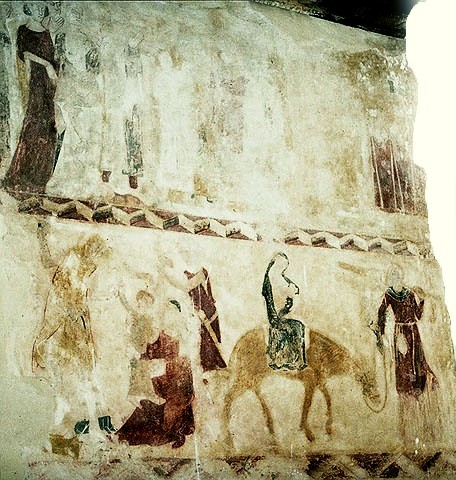Croughton, Northamptonshire (†Peterborough) c.1310
The Flight into Egypt

Croughton once had a very full scheme of 14th century painting, that on the south wall devoted mainly to a Cycle of the Life of the Virgin and one of the Infancy of Christ. Much of both has now gone or is fragmentary and almost indecipherable, but EW Tristram praised these paintings for their quality – he found small amounts of blue and vermilion pigment, traces of underdrawing and setting-out lines, and a general similarity to manuscript painting such as that in the Psalter of Robert de Lisle and the (later) Holkham Hall Bible.¹
At the left above is part of the damaged and incomplete Life of the Virgin, with a very graceful female figure at the left showing well after restoration, and below it are the clearest scenes in the Infancy Cycle. On the left, painted as usual in unflinching detail, is the Massacre of the Innocents; a seated woman in a red robe holds out a baby, which is about to be seized by a mostly obscure soldier holding his sword in readiness above his head. Another soldier, with a scabbard slung at his hip is at the far right holding a child upside down by its foot.
Without a break, the Holy Family are shown making their escape further to the right. Mary, in a blue robe and holding the Christ Child, sits on a plodding yellow donkey, its reins held by Joseph, a staff over his shoulder, at the far right.
The poignant and timeless scene is surrounded like all those on this wall at Croughton by a chevron border, striving for three-dimensionality in a similar manner to the less refined but contemporary examples at Peakirk.
Website for All Saints, Croughton
¹ EW Tristram, Medieval Wall Painting: The Fourteenth Century, pp.73-75 (see Bibliography)